
Frogfishes are any member of the anglerfish family Antennariidae, of the order Lophiiformes. Antennariids are known as anglerfish in Australia, where the term "frogfish" refers to members of the unrelated family Batrachoididae. Frogfishes are found in almost all tropical and subtropical oceans and seas around the world, the primary exception being the Mediterranean Sea.

The spotfin frogfish is a fish of the family Antennariidae, found in all subtropical oceans to depths of 300 m. It grows to 13 cm (5.1 in) in total length. This species can be found in the aquarium trade.

The psychedelic frogfish is a yellow-brown or peach colored frogfish named for its pink and white stripes arranged in a fingerprint pattern. The fish is from waters near Ambon Island and Bali, Indonesia.

The warty frogfish or clown frogfish is a marine fish belonging to the family Antennariidae.

Antennatus is a genus of frogfishes. The last species was described in 2001.

The shaggy frogfish, is a marine fish in the family Antennariidae.
Abantennarius sanguineus, also known as the bloody frogfish or sanguine frogfish, is a Marine fish belonging to the family Antennariidae.
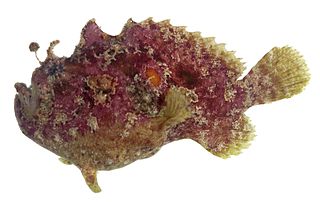
Abantennarius coccineus, the scarlet or freckled frogfish, is a species of frogfish originally classified as Chironectes coccineus and Antennarius coccineus. It lives within tropical waters and has a central distribution being around Indo-East-Pacific areas- excluding Hawaii. The habitat of the scarlet frogfish is in the shallow zones of the ocean. It is found within reef areas, in rocky mounds or sponges where there are places for it to hide amongst from predators. The scarlet frogfish comes in a variety of colours, from tan and brown colours to bright reds and yellows and will grow to a maximum length of 13 centimetres (5.1 in). It can be identified taxonomically through its pectoral rays, the presence of dark patches that appear on its fins and body, along with its lack of distinctive tail base. The scarlet frogfish is not harmful to humans and is not caught by fisheries for consumption purposes, however it has been caught previously for studies relating to the abundance of reef-dwelling fish and as bycatch of shrimp trawling. Similar to other frogfish species, the scarlet frogfish is a predatory carnivore and exhibits a low degree of sociality, only interacting with other scarlet frogfish during their mating period.
Antennarius moai, commonly known as the Moai frogfish, is a species of fish native to Easter Island in the South Pacific. This species was discovered by Gerald R. Allen et al. in the 1970s. FishBase lists this taxon as a synonym of Antennatus coccineus.
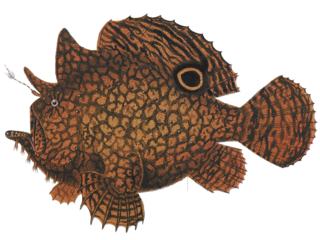
Antennarius biocellatus, commonly known as the brackish-water frogfish or the fishing frog, is a species of fish in the family Antennariidae. Unusually among anglerfishes, it occurs in brackish and occasionally freshwater environments. It is native to the Western Pacific, being known from New Guinea, Indonesia, the Solomon Islands, the Philippines, and Taiwan. It has also been reported from Palau. This species is most frequently seen and collected at depths of less than 10 m (33 ft), and it reaches 14 cm SL.
Abantennarius analis, the tailjet frogfish, tailjet anglerfish or dwarf frogfish, is a species of marine ray-finned fish belonging to the family Antennariidae, the frogfishes. This species is found in the eastern Indian Ocean and the western Pacific Ocean.
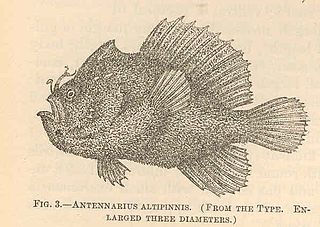
Abantennarius dorehensis, commonly known as the New Guinean frogfish, is a species of fish in the family Antennariidae. It is found throughout the Indo-Pacific including East Africa, the Philippines, New Guinea, the Aldabra Islands, the Ryukyu Islands, the Cocos Islands, and Tahiti. This species occurs in intertidal reef flats and reaches 14 cm in total length. It is an oviparous fish that binds its eggs in thin ribbons or large masses of gelatinous mucus known as egg "rafts" or "veils".

Abantennarius duescus, the side-jet frogfish, is a species of fish in the family Antennariidae. It is native to the Pacific Ocean, where it is known from the Hawaiian Islands, Indonesia, New Caledonia, and Papua New Guinea. It typically occurs at a depth range of 59 to 79 m, although it may be found as far down as 137 m (449 ft), although it has also reportedly been collected in environments less than 30 m (98 ft) deep according to FishBase. It is a very small fish that is only known to reach 3 cm (1.2 in) SL. This species is benthic and oviparous.
Antennatus flagellatus, sometimes known as the whip frogfish, is a species of fish in the family Antennariidae. It is known only from Kashiwajima Island, Kōchi, Japan, and it was described from two specimens collected from a rock ledge on a sandy slope near the island. It occurs at depths of less than 45 m (148 ft) and reaches 4.9 cm SL. This species can be distinguished from other members of the genus Antennatus by its notably long illicium, which can exceed 40% of the fish's standard length.
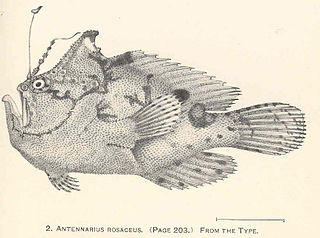
Abantennarius rosaceus, known as the spiny-tufted frogfish, is a species of fish in the family Antennariidae. It is native to the Indo-Pacific, where it is known from the Red Sea, Indonesia, the Philippines, the Gilbert Islands, the Marshall Islands, and Lord Howe Island. It occurs at a depth range of 0 to 130 m, although it is most commonly found at 30 to 40 m, where it is often seen near sponges. It is a small, reef-dwelling, benthic fish, reaching 5.8 cm SL.
Antennatus strigatus, known as the bandtail frogfish, is a species of fish in the family Antennariidae. It is native to the Eastern Pacific, where it ranges from the Gulf of California to Ecuador. It occurs in rocky reefs from the surface down to 15 m (49 ft), or more rarely as deep as 38 m (125 ft). The species is well-camouflaged, typically imitating snails or sponges. It is a demersal species that reaches 8 cm SL.

Antennatus tuberosus, known as the tuberculated frogfish, is a species of fish in the family Antennariidae. It is native to the Indo-Pacific, where it is found from East Africa east to the Philippines, Indonesia, and other islands on the Pacific Plate. It is a benthic reef-dwelling species found, on average, at a depth of around 11.2 m (37 ft), though it is often found in water shallower than that and occasionally much deeper, at up to 73 m (240 ft), and it is a small fish that can reach 9 cm SL. The species is known to be able to change color in the span of two weeks, with individuals shifting from dark gray to light cream to match the experimental aquaria they are kept in. It is oviparous and its eggs are bound in ribbon-like sheaths or large "rafts" or "veils". Like most frogfish, it is reclusive and solitary, sometimes being seen among hard coral branches.
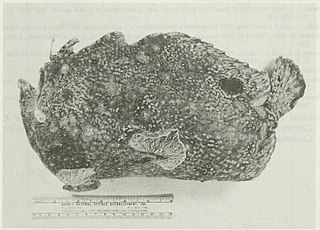
Fowlerichthys avalonis, known as the roughbar frogfish, is a species of fish in the family Antennariidae. It is native to the East Pacific, where it ranges from California's Santa Catalina Island to Peru. This species reaches 33 cm in total length, and it is found in rocky areas from the intertidal zone down to a depth of 300 m (984 ft). Young individuals of this species primarily feed on crustaceans, although they start to consume more and more fish as they grow, with adults primarily feeding on other fish, including fishes their own size, which the frogfish catch by striking quickly with their rapidly expanding mouths, a behavior typical of frogfish and some other anglerfish. The species is demersal and oviparous. This species contains remnants of the previously recognized group of A. ocellatus, which became recovered as their sister group for the Antennarius paraphyletic genus. In other words, this species of frogfish became somewhat of an addition to the widely known group of A. ocellatus, that is directly referring to the oscar fish which can be considered one of the species who has shared part of its evolutionary history with frogfish species, that includes the roughbar frogfish.
Lophiocharon trisignatus, most commonly known as the three-spot frogfish or the spot-tailed anglerfish, is a species of fish in the family Antennariidae. It is native to the Indo-Pacific, where it ranges from Singapore and the Philippines to Australia. It is a benthic species found near inshore reefs at a depth range of 2 to 52 m. The species is oviparous, laying clusters of eggs which are then attached to the side of the male parent's body. It is currently unknown what purpose this serves, although it is thought to either be a brooding strategy or a method for luring potential prey items. It reaches 14.7 cm (5.8 in) SL, making it the largest known member of Lophiocharon, as well as the first of the three to be described, although it was initially placed in the now-invalid genus Chironectes.

Abantennarius is a genus of marine ray-finned fishes belonging to the family Antennariidae, the frogfishes. The fishes in the genus are found in the Indian, Pacific and, one species, in the Western Atlantic Oceans.












